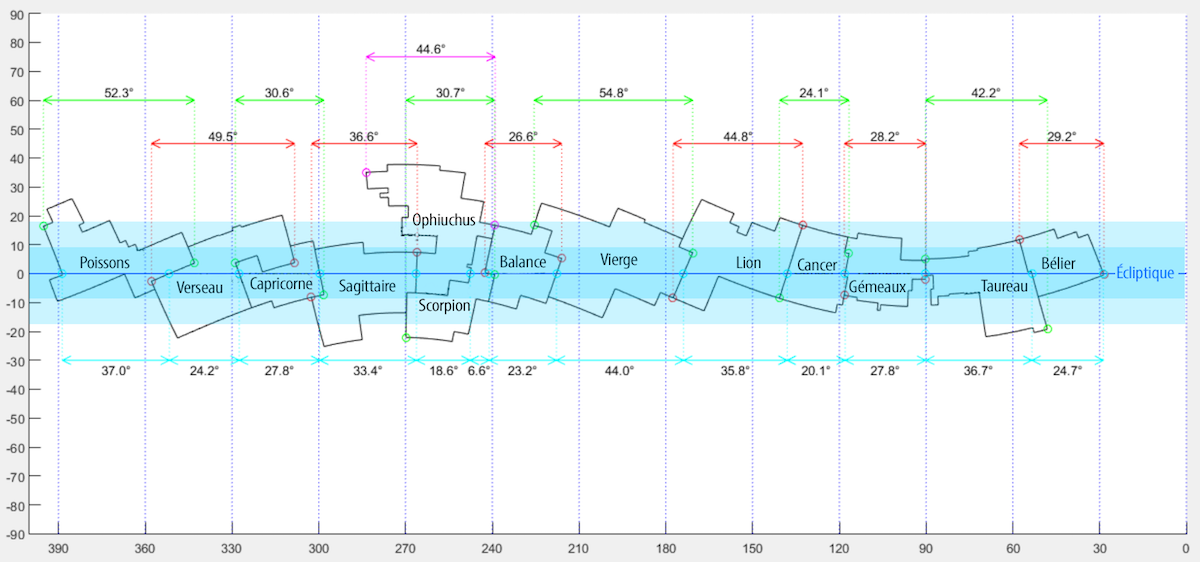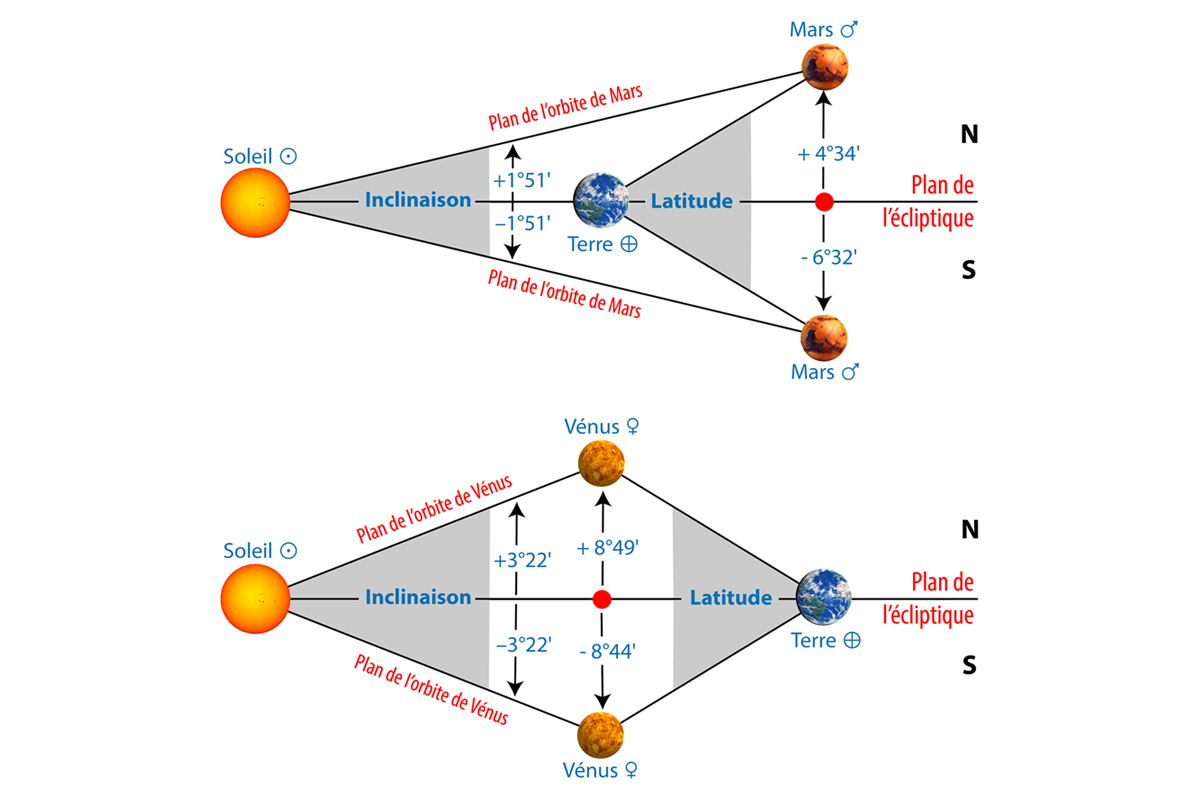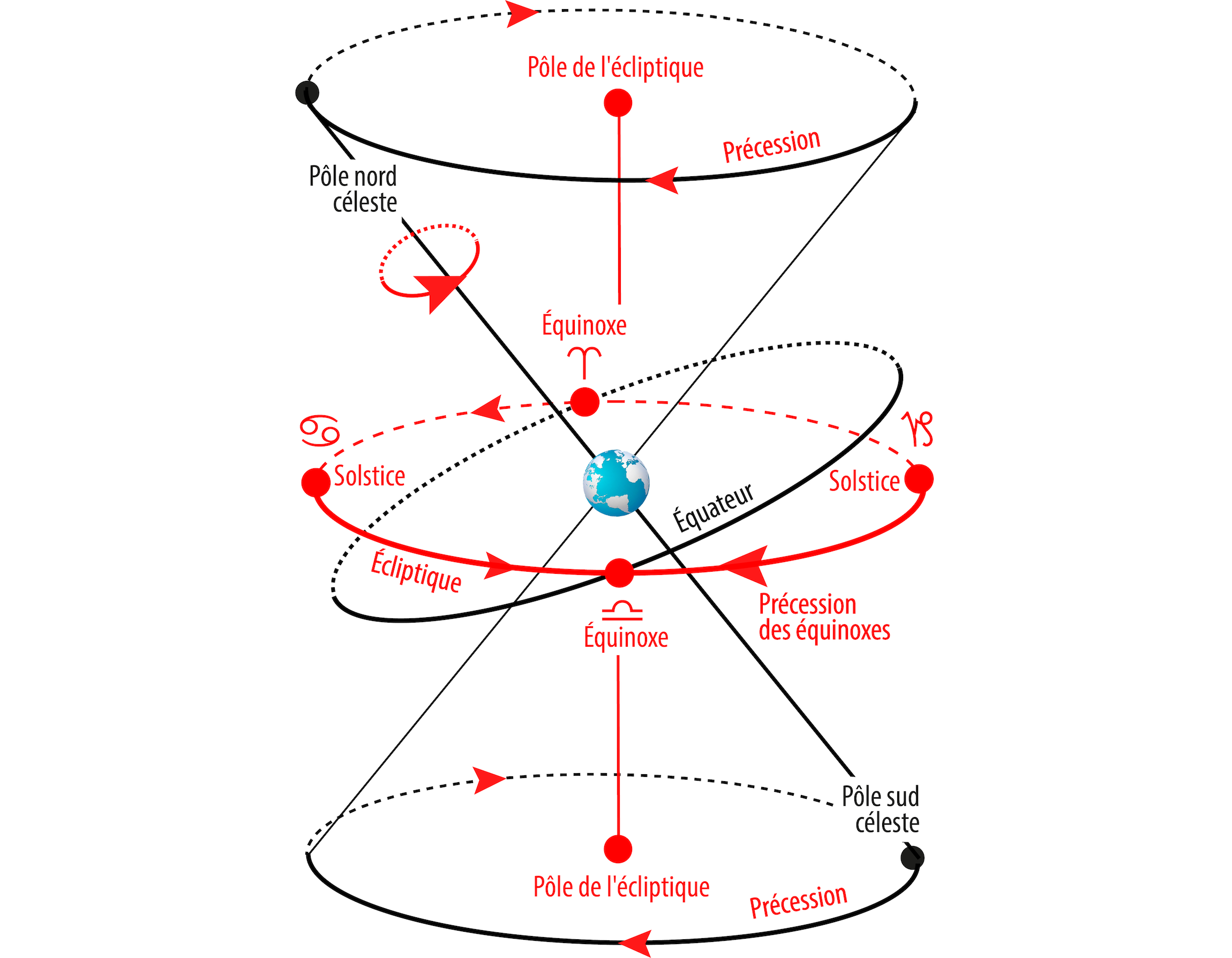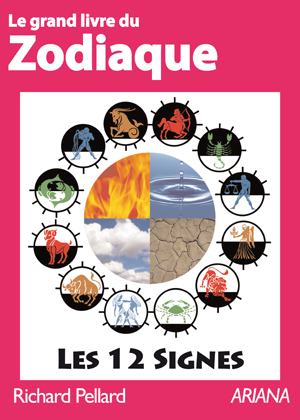Your Planets
Portraits of the Planets
Aspects between Planets
The planetary ages
The planetary families
Planets in Signs
The Planets in comics


The solar zodiac of the Signs is determined by the declinations of the Sun in its apparent geocentric course on the ecliptic, which is tilted on the celestial equator. It should not be confused with the constellations which bear the same name as the Signs and which form their cosmic background. This background is called the zodiacal band, which is approximately 17° wide either side of the ecliptic, and includes the 13 constellations that intersect the ecliptic. Since the orbits of the Moon and the planets are all more or less inclined to the ecliptic, they each have their own zodiac based on their own declinations determined by their specific ecliptic latitudes. Their courses are within the zodiacal band.
The ecliptic is the apparent trajectory described each year by the Sun around the Earth. By definition, the Sun is always exactly on the ecliptic. However, the Sun occupies different positions north or south of the Earth’s equator, depending on the time of year.
The equinoxes correlate with the moment when the Sun is in the plane of the Earth’s equator. The solstices correlate with the moment when the Sun is furthest north or furthest south of the Earth’s equator: it then lies in the plane perpendicular to the axis of the equinoxes.
The March equinox determines the point of origin of the ecliptic longitudes (vernal point): its longitude is therefore 0° by definition.
The 12 Signs of the astronomical zodiac are defined by their ecliptic longitudes, measured with respect to the axes of the equinoxes and solstices. Each Sign occupies a width (W) of exactly 30° in ecliptic longitude:
▶ Aries (Sign): W = 30°, from 0° (March equinox) to 30°
▶ Taurus (Sign): W = 30°, from 30° to 60°
▶ Gemini (Sign): W = 30°, from 60° to 90° (June solstice)
▶ Cancer (Sign): W = 30°, from 90° (June solstice) to 120°
▶ Leo (Sign): W = 30°, from 120° to 150°
▶ Virgo (Sign): W = 30°, from 150° to 180° (September equinox)
▶ Libra (Sign): W = 30°, from 180° (September equinox) to 210°
▶ Scorpio (Sign): W = 30°, from 210° to 240°
▶ Sagittarius (Sign): W = 30°, from 240° to 270° (December solstice)
▶ Capricorn (Sign): W = 30°, from 270° (December solstice) to 300°
▶ Aquarius (Sign): W = 30°, from 300° to 330°
▶ Pisces (Sign): W = 30°, from 330° to 0° (March equinox).
Due to the phenomenon of precession, the ecliptic and the astronomical zodiac are drawn into a slow cycle of 26,000 years of rotation relative to the stellar background.
As a result, the equinoxes, solstices, and ecliptic sectors of the astronomical zodiac are in constant motion relative to the Milky Way, the stars, and the constellations that lie in the background. There are 13 constellations that lie in the background of the ecliptic.
Due to the phenomenon of precession, none of these constellations remain in the same position with respect to the astronomical zodiac Signs. Furthermore, each of these constellations is inscribed within an arbitrary boundary polygon set by the International Astronomical Union (IAU). These polygons all have different irregular shapes. Therefore their ecliptic longitude spans all have different widths (W), some even partially overlapping each other:
▶ Aries (constellation): W ≈ 29.2°
▶ Taurus (constellation): W ≈ 42.2°
▶ Gemini (constellation): W ≈ 28.2°
▶ Cancer (constellation): W ≈ 24.1°
▶ Leo (constellation): W ≈ 44.8°
▶ Virgo (constellation): W ≈ 54.8°
▶ Libra (constellation): W ≈ 26.6°
▶ Scorpius (constellation): W ≈ 30.7°
▶ Ophiuchus (constellation): W ≈ 44.6°
▶ Sagittarius (constellation): W ≈ 36.6°
▶ Capricornus (constellation): W ≈ 30.6°
▶ Aquarius (constellation): W ≈ 49.5°
▶ Pisces (constellation): W ≈ 52.3°
It is also possible to consider only the segments of intersection between the ecliptic and the boundary polygons of the constellations. This restriction artificially eliminates the longitude overlaps of these boundary polygons, resulting in the following widths:
▶ Aries (constellation): W ≈ 24.7°
▶ Taurus (constellation): W ≈ 36.7°
▶ Gemini (constellation): W ≈ 27.8°
▶ Cancer (constellation): W ≈ 20.1°
▶ Leo (constellation): W ≈ 35.8°
▶ Virgo (constellation): W ≈ 44°
▶ Libra (constellation): W ≈ 23.2°
▶ Scorpius (constellation): W ≈ 6.6°
▶ Ophiuchus (constellation): W ≈ 18.6°
▶ Sagittarius (constellation): W ≈ 33.4°
▶ Capricornus (constellation): W ≈ 27.8°
▶ Aquarius (constellation): W ≈ 24.2°
▶ Pisces (constellation): W ≈ 37°
One can observe that the Sun, or a planet moving in close proximity to the ecliptic, can only cross the constellation of Scorpius over 6.6° of ecliptic longitude. This does not change the fact that the astronomical Sign of Scorpio extends over 30° of ecliptic longitude and is characterized by a declination between −11° 29′ and −20° 10′: the presence of a Planet in the astronomical Sign of Scorpio is determined by the ecliptic coordinates of this Planet, and not by the distant constellation which can be found in the background.
The table below summarizes these various measures. The ±17° zodiacal band in light blue represents the maximum northern and southern ecliptic latitudes of Pluto. The one in dark blue represents the maximum northern and southern ecliptic latitudes of Venus (±8° 45′):

The figure below represents the inclinations of the orbits of Venus and Mars on the ecliptic and their maximum northern and southern ecliptic latitudes, the latter ones being a function of their distance to Earth:

While the 12 Signs of the astronomical zodiac cover all the possible positions of the Planets in ecliptic longitude and latitude, the 13 constellations in the background of the ecliptic cover only a part of the possible positions of the Planets.
Indeed, with the exception of the Sun and the Earth, none of the solar system bodies orbits exactly within the ecliptic plane: some Planets can periodically cross significant ecliptic latitudes (e.g.: Moon ±5°, Mercury ±5°, Venus ±8° Pluto ±17°) and escape from the belt of the 13 ecliptic constellations.
There are 13 constellations located north of the ecliptic constellations and likely to be crossed by Planets with high ecliptic latitudes (in particular by the Moon, Mercury, Venus, Mars or Pluto): Triangulum, Perseus, Auriga, Lynx, Leo Minor, Coma Berenices, Serpens Caput, Serpens Cauda, Scutum, Aquila, Equuleus, Pegasus, Andromeda.
There are 13 constellations located south of the ecliptic constellations and likely to be crossed by Planets with high ecliptic latitudes (in particular by the Moon, Mercury, Venus, Mars or Pluto): Orion, Monoceros, Canis Minor, Hydra, Sextans, Crater, Corvus, Centaurus, Lupus, Corona Australis, Microscopium, Piscis Austrinus, Cetus.
Video caption:
▶ the year (from −13,000 to 13,000) is indicated at the very top
▶ IAU constellation boundaries: blue outlines
▶ ecliptic plane: red horizontal axis
▶ ecliptic longitudes: horizontal graduations
▶ ecliptic latitudes: vertical graduations
▶ position of the Sun at March equinox: green icon
▶ position of the Sun at June solstice: yellow icon
▶ position of the Sun at September equinox: orange icon
▶ position of the Sun at December solstice: purple icon
March equinox is the time of the year when the Sun crosses the Earth’s equator from south to north. The Sun is then at the intersection of the planes of the Earth’s equator and the ecliptic (apparent trajectory described each year by the Sun around the Earth).
This specific direction of the Sun at March equinox is called the vernal point: it is used to define the point of origin of the ecliptic longitudes (0°) and the ecliptic sectors of the astronomical zodiac.
In the astronomical zodiac, Pisces is defined as the sector between 330° and 0° ecliptic longitude, while Aries is defined as the sector between 0° and 30° ecliptic longitude. March equinox correlates with the Sun crossing 0° ecliptic longitude: this is precisely when the Sun is leaving the ecliptic sector of astronomical Pisces and entering that of astronomical Aries.
Throughout the northern hemisphere, this is the end of astronomical winter and the beginning of astronomical spring. Throughout the southern hemisphere, this is the end of astronomical summer and the beginning of astronomical autumn.
Video caption:
▶ the year (from −13,000 to 13,000) is indicated at the very top
▶ plane of the Earth’s equator: red horizontal axis
▶ plane of the Earth’s axis: red vertical axis
▶ ecliptic plane: red oblique axis
▶ ecliptic longitudes: graduations on the red oblique axis
▶ position of the Sun at March equinox: yellow icon
June solstice is the time of the year when the Sun reaches its northernmost position above the Earth’s equator, at the vertical of the Tropic of Cancer. The Sun is then at the intersection between the plane perpendicular to the axis of the equinoxes and the ecliptic plane (apparent trajectory described each year by the Sun around the Earth).
In the astronomical zodiac, Gemini is defined as the sector between 60° and 90° ecliptic longitude, while Cancer is defined as the sector between 90° and 120° ecliptic longitude. June solstice correlates with the Sun crossing 90° ecliptic longitude: this is precisely when the Sun is leaving the ecliptic sector of astronomical Gemini and entering that of astronomical Cancer.
Throughout the northern hemisphere, this is the end of astronomical spring and the beginning of astronomical summer. Throughout the southern hemisphere, this is the end of astronomical autumn and the beginning of astronomical winter.
Video caption:
▶ the year (from −13,000 to 13,000) is indicated at the very top
▶ plane of the Earth’s equator: red horizontal axis
▶ plane of the Earth’s axis: red vertical axis
▶ ecliptic plane: red curve
▶ ecliptic longitudes: graduations on the red curve
▶ position of the Sun at June solstice: yellow icon
September equinox is the time of the year when the Sun crosses the Earth’s equator from north to south. The Sun is then at the intersection of the planes of the Earth’s equator and the ecliptic (apparent trajectory described each year by the Sun around the Earth).
In the astronomical zodiac, Virgo is defined as the sector between 150° and 180° ecliptic longitude, while Libra is defined as the sector between 180° and 210° ecliptic longitude. September equinox correlates with the Sun crossing 180° ecliptic longitude: this is precisely when the Sun is leaving the ecliptic sector of astronomical Virgo and entering that of astronomical Libra.
Throughout the northern hemisphere, this is the end of astronomical summer and the beginning of astronomical autumn. Throughout the southern hemisphere, this is the end of astronomical winter and the beginning of astronomical spring.
Video caption:
▶ the year (from −13,000 to 13,000) is indicated at the very top
▶ plane of the Earth’s equator: red horizontal axis
▶ plane of the Earth’s axis: red vertical axis
▶ ecliptic plane: red oblique axis
▶ ecliptic longitudes: graduations on the red oblique axis
▶ position of the Sun at September equinox: yellow icon
December solstice is the time of the year when the Sun reaches its southernmost position below the Earth’s equator, at the vertical of the Tropic of Capricorn. The Sun is then at the intersection between the plane perpendicular to the axis of the equinoxes and the ecliptic plane (apparent trajectory described each year by the Sun around the Earth).
In the astronomical zodiac, Sagittarius is defined as the sector between 240° and 270° ecliptic longitude, while Capricorn is defined as the sector between 270° and 300° ecliptic longitude. December solstice correlates with the Sun crossing 270° ecliptic longitude: this is precisely when the Sun is leaving the ecliptic sector of astronomical Sagittarius and entering that of astronomical Capricorn.
Throughout the northern hemisphere, this is the end of astronomical autumn and the beginning of astronomical winter. Throughout the southern hemisphere, this is the end of astronomical spring and the beginning of astronomical summer.
Video caption:
▶ the year (from −13,000 to 13,000) is indicated at the very top
▶ plane of the Earth’s equator: red horizontal axis
▶ plane of the Earth’s axis: red vertical axis
▶ ecliptic plane: red curve
▶ ecliptic longitudes: graduations on the red curve
▶ position of the Sun at December solstice: yellow icon
The axis of rotation of the Earth is not completely perpendicular to the ecliptic: it is indeed tilted by approximately 23.5° away from the perpendicular. This is the same tilt angle that can be found between the planes of the earth’s equator and the ecliptic. The value of this tilt angle remains particularly stable over the millennia.

However, the direction in which the Earth’s axis is pointing is not perfectly fixed: this direction rotates very slowly instead, describing a 23.5° cone in space, during a cycle lasting approximately 26,000 years. One speaks of “precession” to refer to this cyclic rotation of the direction of the Earth’s axis.
Due to the phenomenon of precession, the ecliptic and the astronomical zodiac are drawn into a slow cycle of 26,000 years of rotation relative to the stellar background. As a result, the equinoxes, solstices, and ecliptic sectors of the astronomical zodiac are in constant motion relative to the Milky Way, the stars, and the constellations that lie in the background. This phenomenon of precession also causes the celestial poles to move slowly.
Currently (21st century), the Earth’s axis is pointing north towards the North Star, the brightest star in the constellation Ursa Minor. Several millennia ago the Earth’s axis was pointing towards other stars. Several millennia from now the Earth’s axis will be pointing to yet other stars.
The north celestial pole is the direction of the sky lying north along the axis of rotation of the Earth: it is therefore located at the vertical of the terrestrial north pole. The north ecliptic pole is the direction of the sky lying north along the perpendicular to the ecliptic plane (apparent trajectory described each year by the Sun around the Earth).
Video caption:
▶ the year (from −13,000 to 13,000) is indicated at the very top
▶ the graduations on the precession circle indicate the position of the north celestial pole depending on the year
▶ the approximate directions of the ecliptic sectors of the astronomical zodiac are watermarked on the image edges
The south celestial pole is the direction of the sky lying south along the axis of rotation of the Earth: it is therefore located at the vertical of the terrestrial south pole. The south ecliptic pole is the direction of the sky lying south along the perpendicular to the ecliptic plane (apparent trajectory described each year by the Sun around the Earth).
Video caption:
▶ the year (from −13,000 to 13,000) is indicated at the very top
▶ the graduations on the precession circle indicate the position of the south celestial pole depending on the year
▶ the approximate directions of the ecliptic sectors of the astronomical zodiac are watermarked on the image edges
Simulations created with the Stellarium freeware. Stereographic projections. One second of video corresponds to one century in real time: the videos therefore show time accelerated by a factor of around 3 billion.
The zodiac of the Signs and that of the constellations cannot be confused. Claudius Ptolemy who had compiled Hipparchus, the discoverer of precession, explains the denominations of the Signs by solar phenomena (tropical year) and not by stellar arrangements. The following text from 2nd century AD shows without possible dispute that post-Chaldean astrologers, even using fixed stars, linked the zodiac to the seasonal phases:
“There are indeed two tropic Signs, on the one hand the first interval of thirty degrees from the summer solstice, i.e. the Sign of Cancer, on the other, the first from the winter solstice, i.e. Capricorn. These Signs have received their name from what is going on within them. Indeed the Sun, when it has entered these Signs, goes backwards, turning its course in an opposite latitude, causing summer in Cancer, and in Capricorn, winter.” “There are furthermore two equinoctial Signs, Aries in spring and Libra in autumn, which also took their name from what happens within them, because when the Sun is at the beginning of these Signs, the spaces of the day and the night are equal for all the Earth.”
Closer to us in time, in the 18th century, an astronomer unlikely to have pro-astrological sentiments, François Arago, expressed in his Astronomie populaire his understanding of the differences: “Care must therefore be taken, to avoid any confusion, to clearly distinguish the word constellation from the word Sign. The constellations are figures of men or animals, drawn in the zodiac, and having, as we have already said, no relation to the disposition of the stars which they contain. The Signs are divisions of 30 degrees each, without any necessary connection with the constellations whose names they bear. By virtue of the precession of the equinoxes the Signs no longer coincide with the constellations.”
▶ The zodiac and the precession of the equinoxes
▶ Your zodiac Sign
▶ Signs and seasons
▶ Planetary trios in Signs
▶ The world according to Claudius Ptolemy, astronomer-astrologer and lighthouse of Alexandria
▶ The astronomical reality of the zodiac
▶ The human reflexology zodiac
▶ Autour du zodiaque : de l’eau dans un Signe de Feu ?
▶ Zodiaque et sphère locale
▶ Mythologie du zodiaque
▶ Zodiaque et formes de l’inhibition
▶ Do we change character by changing Sun sign?
▶ Énergie-Espace-Temps-Structure et zodiaque
▶ Genèse du zodiaque conditionaliste
▶ L’horloge photopériodique du genou
▶ Sun Sign and Rising Sign
▶ Astrologie, adaptation & inadaptation
▶ Les rythmes du zodiaque
▶ Simplified cosmography of the solar system
▶ Thème de domitude et hiérarchisation planétaire
▶ Effets et contre-effets des images et représentations sur les faits et les idées
▶ Le taijitu dans le système solaire
▶ Zodiac, planets and Jungian typology

Le grand livre du zodiaque
par
180 pages. Illustrations en couleur.
Ce livre présente et explique les trois zodiaques : celui du décor des constellations, celui de l’astrologie traditionnelle basé sur les Quatre Éléments symboliques (Feu, Terre, Air & Eau) et celui de l’astrologie naturelle basé sur les phénomènes astronomiques objectifs.
Téléchargez-le dès maintenant dans notre boutique